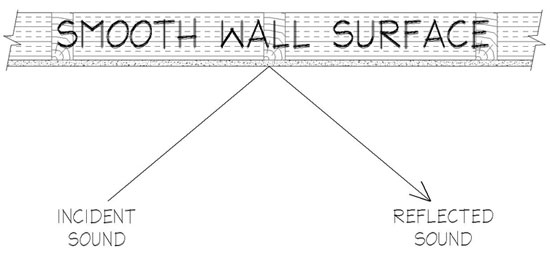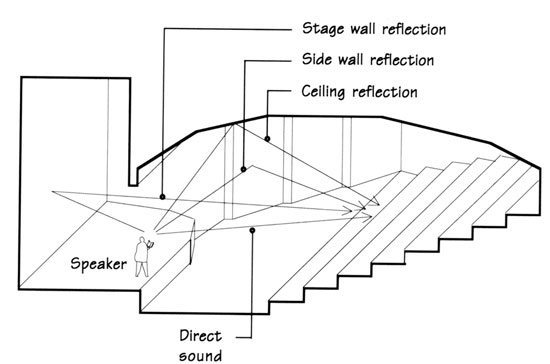Noise Control and Room Acoustics in Building Design
Traditional acoustic wall panels. With its variety of shaped edges and panel thicknesses, the traditional acoustical wall panel offers design versatility and a solution for controlling reverberant noise while also controlling sound reflections in the room. Fiberglass core acoustical panels faced in fabric or vinyl can be placed on the walls or ceiling. Typically they are fabricated from 6-7 PCF fiberglass board with edges chemically hardened for durability. Maximum panel sizes are typically 4 ft. x 10 ft. Angled or contoured perimeter cut custom shapes can be specified. A 2 in. thick panel typically has an NRC value of 1.00.
Applications include any interior surfaces where superior acoustical performance is required, such as conference rooms, auditoriums, churches, media rooms and office spaces.
Cloud system. For enhanced reverberant noise absorption, an acoustical cloud system of acoustical panels can be used in spaces where ceilings are too low for vertical baffle installations. Cloud panels can be located to not interfere with sprinkler or lighting and can be backlit with low voltage lighting.
High impact acoustical wall panel. For applications where acoustical performance must be teamed with greater durability, such as in gymnasiums, a high impact panel can be specified. A typical two-part panel has a 6-7 PCF density core with a 1/8 in. thick, high density impact resistant skin laminated on the core face.
Corrosion-resistant aluminum or galvanized steel panels. These are suited for controlling reverberant noise problems in gymnasiums, natatoriums, and recreation centers. Some manufacturers fill panels with a 2-in.-thick, glass fiber sound absorber encapsulated in a heat sealed poly vinyl bag.
Wood-faced absorption panels. One typical panel is made with a ¾-inch-thick MDF core with a laminated hardwood veneer facing that is perforated. Designers can select from different perforation patterns and wood types Each panel is backed with an acoustically transparent black fabric to visually cover the sound batting, furring, and attachment hardware, which make up the substrate behind each panel.
 |
Specular sound reflections off of flat wall and ceiling surfaces often produce inconsistent poor acoustic quality throughout the listening space; Image provided by Kinetics Noise Control |
 |
Reflective design in an auditorium or lecture hall. Ceiling and wall shaping directs sound to mid and rear seating areas. Image provided by Kinetics Noise Control |









